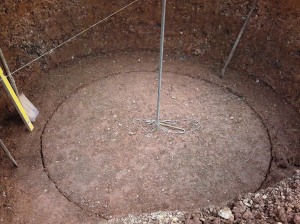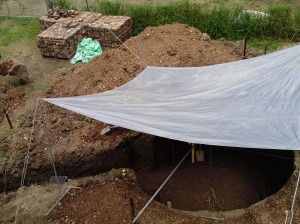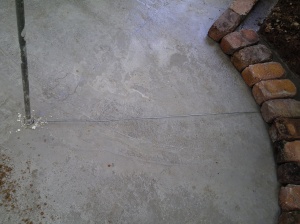


|
Commenced:
|
01/03/2012 |
|---|---|
|
Submitted:
|
25/03/2012 |
|
Last updated:
|
28/10/2020 |
|
Location:
|
93 Golden Gully Road, Kin Kin, QLD, AU |
|
Phone:
|
0754854664 |
|
Website:
|
http://permeco.org |
|
Climate zone:
|
Sub tropical |
(projects i'm involved in)
Project: PermEco Inc.
Posted by Zaia Kendall about 11 years ago
Tom had to re-do some fencing and clear the site for the bio-digester. He calculated that with the amount of manure we are getting (around 30kg per day), we need a 5 cubic metre bio-digester, which will give us around 1 1/2 cubic metres of gas per day. 
Lead up time to get the gas going will be around 60 days once we start filling the bio-digester. But we are not there yet, and here I have documented the start of the project.
We got a lot of questions about how we dealt with council etc. Since this is for private use and we are not selling the gas commercially, there are no hoops we need to jump through. So we cleared the site and started digging.
Tom drew where he needed to dig on the ground, whereupon he used the excavator to dig the round hole (2.8 diameter), plus a square hole which will be part of the outlet. He also marked out where the inlet will be (small round circle on the right). He had to regularly check levels, to ensure the bottom was level and the sides of the hole were straight.
The hole was then further dug out by hand, ensuring the levels were correct and walls were straight. Tom then put a pole in the middle and measured the inner radius, thus determining where the bricks would need to go.

A tarp had to be placed over the hole, since we were experiencing some wet weather, and we needed a dry area to pour the concrete and did not want the hole to fill up with water.

To ensure a good foundation, the outer circle (where the bricks will be for the walls) was dug out deeper. This way there is more concrete under the wall to hold its weight, which makes it stronger. We were lucky, there was only a little bit of water in the bottom of the outer circle, which meant that water had only just been struck. This was of no concern at this time, but strategies will be put in place to divert water past the bio-digester in wetter times.
We put down rio mesh and then the concrete was poured. The post stayed in the middle so that we could still measure where the bricks were supposed to go. Once the concrete was hard, Tom attached some wire to the centre post which was as long as the inner radius, and then measured out where the bricks had to go. He marked the concrete with blue pencil and laid the bricks out so everyone could see where they were supposed to go and how they needed to be laid.

They laid one layer of bricks that day. In the coming weeks we will add some more layers of bricks until we have a wall about a metre high. Then we can start the second stage of the bio-digester: The dome!
To be involved in the next stage of the bio-digester, "The Dome", please click here for dates and to book.
You must be logged in to comment.
Note: The various badges displayed in people profiles are largely honesty-based self-proclamations by the individuals themselves. There are reporting functions users can use if they know of blatant misrepresentation (for both people and projects). Legitimacy, competency and reputation for all people and projects can be evidenced and/or developed through their providing regular updates on permaculture work they’re involved in, before/after photographs, etc. A spirit of objective nurturing of both people and projects through knowledge/encouragement/inspiration/resource sharing is the aim of the Worldwide Permaculture Network.
 |
MemberA member is a permaculturist who has never taken a PDC course. These cannot become PDC teachers. Members may be novice or highly experienced permaculturists or anywhere in between. Watch their updates for evaluation. |
|---|---|
  |
Permaculture MatchmakerOne of these badges will show if you select your gender and the "I'm single, looking for a permaculture partner" option in your profile. |
 |
PDCPeople who claim to have taken a Permaculture Design Certificate (PDC) course somewhere in the world. |
 |
PDC VerifiedPeople who have entered an email address for the teacher of their PDC course, and have had their PDC status verified by that teacher. Watch their updates for evaluation. |
 |
PRI PDCPeople who’ve taken a Permaculture Research Institute PDC somewhere in the world. |
 |
PDC TeacherPeople who claim to teach some version of PDC somewhere in the world. |
 |
PRI TeacherWith the exception of the ‘Member’ who has never taken a PDC, all of the above can apply to become a PRI PDC Teacher. PRI PDC Teachers are those who the PRI recognise, through a vetting board, as determined and competent to teach the full 72-hour course as developed by Permaculture founder Bill Mollison – covering all the topics of The Designers’ Manual as well as possible (i.e. not cherry picking only aspects the teacher feels most interested or competent in). Such teachers also commit to focussing on the design science, and not including subjective spiritual/metaphysical elements. The reason these items are not included in the PDC curriculum is because they are “belief” based. Permaculture Design education concerns itself with teaching good design based on strategies and techniques which are scientifically provable. PRI PDC Teachers may be given teaching and/or consultancy offerings as they become available as the network grows. |
 |
Aid WorkerThe individual with this badge is indicating they are, have, or would like to be involved in permaculture aid work. As such, the individual may or may not have permaculture aid worker experience. Watch their updates for evaluation. |
 |
ConsultantThe individual with this badge is indicating they are, have, or would like to do paid permaculture design consultancy work. As such, the individual may or may not have permaculture consultancy experience. Watch their updates for evaluation. |
 |
Community ProjectCommunity projects are projects that help develop sustainable community interaction and increase localised resiliency. |